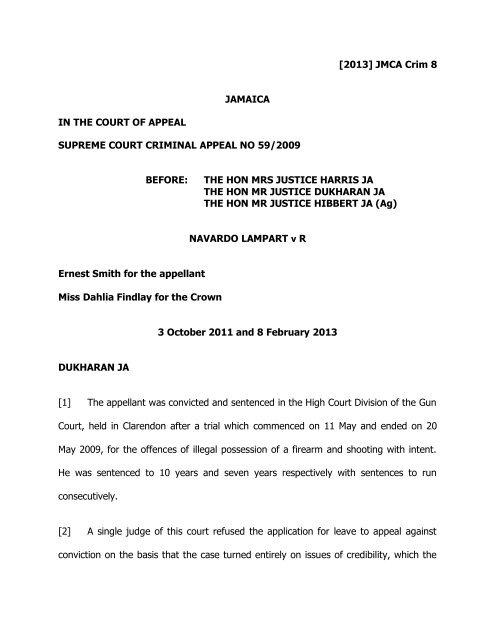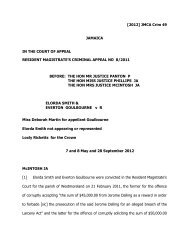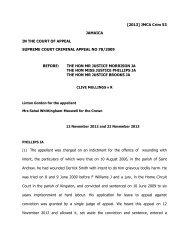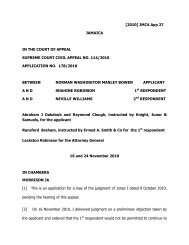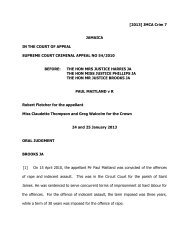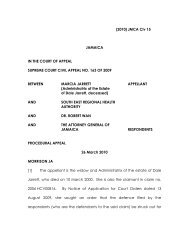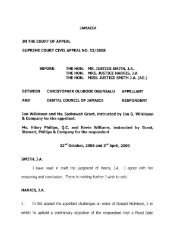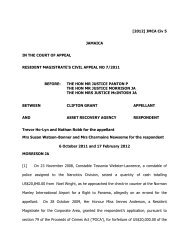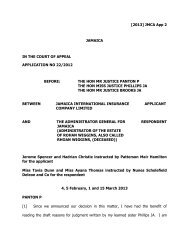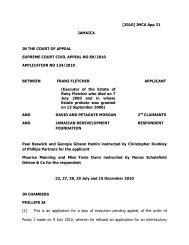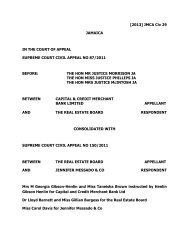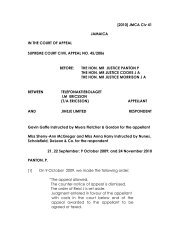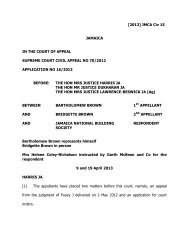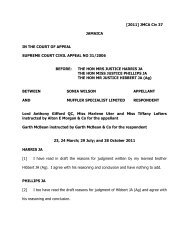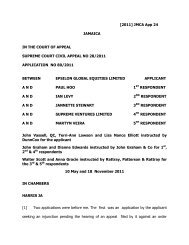Lampart (Navardo) v R.pdf - The Court of Appeal
Lampart (Navardo) v R.pdf - The Court of Appeal
Lampart (Navardo) v R.pdf - The Court of Appeal
Create successful ePaper yourself
Turn your PDF publications into a flip-book with our unique Google optimized e-Paper software.
[2013] JMCA Crim 8<br />
JAMAICA<br />
IN THE COURT OF APPEAL<br />
SUPREME COURT CRIMINAL APPEAL NO 59/2009<br />
BEFORE:<br />
THE HON MRS JUSTICE HARRIS JA<br />
THE HON MR JUSTICE DUKHARAN JA<br />
THE HON MR JUSTICE HIBBERT JA (Ag)<br />
NAVARDO LAMPART v R<br />
Ernest Smith for the appellant<br />
Miss Dahlia Findlay for the Crown<br />
3 October 2011 and 8 February 2013<br />
DUKHARAN JA<br />
[1] <strong>The</strong> appellant was convicted and sentenced in the High <strong>Court</strong> Division <strong>of</strong> the Gun<br />
<strong>Court</strong>, held in Clarendon after a trial which commenced on 11 May and ended on 20<br />
May 2009, for the <strong>of</strong>fences <strong>of</strong> illegal possession <strong>of</strong> a firearm and shooting with intent.<br />
He was sentenced to 10 years and seven years respectively with sentences to run<br />
consecutively.<br />
[2] A single judge <strong>of</strong> this court refused the application for leave to appeal against<br />
conviction on the basis that the case turned entirely on issues <strong>of</strong> credibility, which the
learned trial judge resolved in favour <strong>of</strong> the prosecution as he was entitled on the<br />
evidence to do. However, the application for leave to appeal sentence was granted.<br />
This is a renewal <strong>of</strong> the application for leave to appeal conviction.<br />
[3] On 3 October 2011, we heard arguments when we refused the application for<br />
leave to appeal the convictions. However, the appeal against sentence was allowed in<br />
part, in that, the consecutive element in the sentence was set aside, and instead, the<br />
sentences on both counts were ordered to run concurrently and to run from 20 August<br />
2009. We promised then to put our reasons in writing and this is a fulfillment <strong>of</strong> that<br />
promise.<br />
Prosecution’s Case<br />
[4] <strong>The</strong> prosecution relied on section 20 (5)(a) <strong>of</strong> the Firearms Act in order to prove<br />
that although the appellant himself had not been in actual possession <strong>of</strong> a firearm, by<br />
virtue <strong>of</strong> that section, he ought to be treated as being in possession. <strong>The</strong> prosecution<br />
had to show: that the applicant was in the company <strong>of</strong> the principal <strong>of</strong>fender and that<br />
the principal <strong>of</strong>fender must have used the firearm to commit the <strong>of</strong>fence; the existence<br />
<strong>of</strong> circumstances which gave rise to the reasonable presumption that he was present to<br />
aid and abet the commission <strong>of</strong> such <strong>of</strong>fence; and the absence <strong>of</strong> reasonable excuse.<br />
[5] <strong>The</strong> relevant facts are that on 19 January 2009, at about 10:00am, Constables<br />
Davion Lindsay and Jarrett Walker were on patrol in a marked police vehicle along<br />
Howard Avenue, May Pen, in the parish <strong>of</strong> Clarendon.<br />
Both <strong>of</strong>ficers observed a<br />
speeding green and black station wagon motor car. <strong>The</strong>re were two men in the back
and the driver alone in the front. <strong>The</strong> police followed the speeding car and attempted<br />
to pull it over by flashing their blue lights, honking the beacon horn and asking them to<br />
stop, using the Public Address System installed on their vehicle.<br />
<strong>The</strong> police finally<br />
caught up with the speeding vehicle which was in a line <strong>of</strong> traffic. Constable Lindsay<br />
came out <strong>of</strong> the police car and approached it when it sped <strong>of</strong>f. What followed was a<br />
chase that involved many <strong>of</strong> the streets in May Pen and a period when the police lost<br />
sight <strong>of</strong> the vehicle in the Western Park area. <strong>The</strong>re was a reappearance <strong>of</strong> the car on<br />
Glenmuir Road a few minutes later. <strong>The</strong> chase continued when the speeding vehicle<br />
collided with another vehicle and continued travelling until it ended on a dirt road up a<br />
hill. <strong>The</strong> vehicle then came to a stop.<br />
[6] Constable Lindsay said he saw two men alighting from the two rear doors. He<br />
heard explosions coming from the direction <strong>of</strong> the men, who fired at them. Constable<br />
Lindsay said he returned the fire with his M16 rifle.<br />
[7] <strong>The</strong>re was another attempt by the driver <strong>of</strong> the car to speed away. This time he<br />
did not get very far as he crashed into a stone. Constable Lindsay said he saw a man<br />
come out <strong>of</strong> the driver’s seat and run towards the bushes. He chased him and the man<br />
shouted, “Mi get shot, mi get shot”. He was apprehended and he said, “Ah taxi mi ah<br />
run, mi no know them.” This man is the appellant. He was taken to the May Pen<br />
hospital for treatment where he was subsequently arrested and charged for illegal<br />
possession <strong>of</strong> a firearm and shooting with intent.
Defence<br />
[8] <strong>The</strong> appellant gave evidence in his defence. His defence was that he was alone<br />
in his car and that he was on Stork Street and not Howard Street as the police said. He<br />
admitted to fleeing from the police, but not via the route in the evidence given by the<br />
police. He said he was trying to get to Buck Common where his relatives were living.<br />
His reason for trying to evade the police was that his cover note (insurance) had<br />
expired and the police would seize his car for operating a robot taxi. He also feared<br />
that he would be accused <strong>of</strong> having something illegal in his possession if the police<br />
were to apprehend him.<br />
[9] <strong>The</strong> appellant called three witnesses in his defence. <strong>The</strong> evidence given by these<br />
witnesses concerned what happened subsequent to the apprehension <strong>of</strong> the appellant<br />
and would not have assisted the appellant in the rebuttal <strong>of</strong> the prosecution’s case.<br />
[10] <strong>The</strong> first witness for the defence was Marcia <strong>Lampart</strong>. She said the appellant is<br />
her nephew. On 19 January 2009, he ran towards her with his hands in blood and said<br />
to her, “Auntie look what dey do to mi hand dem and ah don’t do anything.” She said<br />
he was eventually put in a police car and taken away.<br />
[11] <strong>The</strong> second witness for the defence was Omar Rhoden. He told the court he<br />
knew the appellant from school days. On 19 January 2009 he saw him at Stork Street<br />
in May Pen and they discussed the sale <strong>of</strong> a phone to him (the witness). After that, the<br />
appellant drove <strong>of</strong>f alone in a car.
[12] <strong>The</strong> third witness was Wavelyn Daley. She testified that she is a bartender living<br />
in Bucks Common and she knows the appellant. She said on the day in question she<br />
saw him driving and as he passed her gate she heard explosions. Shortly afterwards,<br />
she saw him coming out <strong>of</strong> the car crying and saying, “<strong>The</strong>m shot mi, them shot mi.”<br />
She saw two police <strong>of</strong>ficers. She never saw anyone else come from the appellant’s car.<br />
Grounds <strong>of</strong> <strong>Appeal</strong><br />
[13] Mr Smith, for the appellant, abandoned the original grounds, sought and was<br />
granted leave to argue three supplemental grounds which are as follows:<br />
“(1) That the Learned Trial Judge did not address the<br />
contradictions in the evidence <strong>of</strong> Constable Damion<br />
Lindsay on the question <strong>of</strong> the ‘man’ who alighted<br />
from the left rear door <strong>of</strong> the car driven by the<br />
appellant.<br />
At page 14, lines 18 to 25 [sic] person was dressed in<br />
burgundy type short [sic].<br />
At page 23, lines 1 and 2 [sic] person [sic] dressed in<br />
white t-shirt.<br />
Such a contradiction points to the fact that no person<br />
came from the rear <strong>of</strong> the vehicle.<br />
(2) That the Learned Trial Judge failed to address the<br />
physical evidence from Detective Sergeant Garth<br />
Michelin where the vehicle was damaged by gunshots<br />
which clearly shows that if any person was in the<br />
back seat <strong>of</strong> the car such person or persons would<br />
have been shot in the upper torso.<br />
(3) That the sentence <strong>of</strong> ten and seven years respectively<br />
to run consecutively imposed on the appellant was<br />
harsh and excessive.”
Ground 1<br />
[14] <strong>The</strong> complaint <strong>of</strong> Mr Smith was that the learned trial judge failed to address the<br />
contradictions and discrepancies in the evidence given by Constable Lindsay, in<br />
particular, at page 14 <strong>of</strong> the transcript, lines 18-25, which read:<br />
“Q.<br />
You said that you weren’t able to see the person on<br />
the right as good as you saw the person on the left.<br />
And did you notice anything about the person on the<br />
left that exited from the right rear?<br />
A. He was in some burgundy type <strong>of</strong> shirt.<br />
Q. Can you say what happened to the man on your left<br />
after you heard the gunshot?”<br />
In the first two lines on page 23, the witness referred to the man on the left as wearing<br />
a white t-shirt.<br />
[15] Mr Smith submitted that such a contradiction pointed to the fact that no one<br />
came from the rear <strong>of</strong> the vehicle.<br />
[16] Guidance as to the amount <strong>of</strong> detail necessary in a judge’s summation when he<br />
is the arbiter <strong>of</strong> fact has been given by this court in R v Junior Carey SCCA No<br />
25/1985 (delivered 31 July 1986), where the court refuted a suggestion that the trial<br />
judge had a duty to minutely go through each piece <strong>of</strong> viva voce evidence for the<br />
record. As Campbell JA stated at page 8:<br />
“<strong>The</strong> learned trial judge is not statutorily required to do any<br />
such thing even though a desirable practice has developed<br />
which it is hoped will be continued <strong>of</strong> setting out salient
findings <strong>of</strong> fact which is <strong>of</strong> inestimable value should an<br />
appeal be taken.”<br />
Clearly, the trial judge is therefore not bound to sum up every discrepancy, real or<br />
apparent.<br />
[17] This case rested on the credibility <strong>of</strong> the accounts <strong>of</strong> the incident advanced by<br />
the prosecution’s witnesses and those <strong>of</strong> the defence. <strong>The</strong> learned trial judge clearly<br />
accepted the prosecution’s account while rejecting the defence. <strong>The</strong>re was evidence on<br />
which he was entitled to do so. We see no merit in this ground.<br />
Ground 2<br />
[18] Mr Smith submitted that the learned trial judge did not address the physical<br />
evidence from Detective Sergeant Garth Michelin where the vehicle was damaged by<br />
gunshots, which shows that if anyone was in the back seat <strong>of</strong> the car, the person or<br />
persons would have been shot in the upper torso.<br />
He further submitted that the<br />
physical evidence suggested that no one except the applicant exited from the vehicle.<br />
[19] <strong>The</strong> learned trial judge did make reference to this particular evidence in his<br />
summation at page 126 when he stated, in relation to Detective Sergeant Michelin’s<br />
evidence, “He observed the car and observed a bullet hole in the left rear <strong>of</strong> the<br />
passenger door. … he observed that the left rear door window was shattered.” <strong>The</strong><br />
learned trial judge found the version put forward by the defence that there was no<br />
shootout, as lacking credibility and was satisfied so as to feel sure that the witnesses<br />
for the prosecution were truthful and credible. This ground also lacks merit.
Ground 3<br />
[20] It was submitted that the consecutive element in the sentences imposed by the<br />
learned trial judge was manifestly excessive as the <strong>of</strong>fences charged related to one and<br />
the same transaction. Counsel cited Kirk Mitchell v R [2011] JMCA Crim 1.<br />
[21] This court has said on a number <strong>of</strong> occasions that usually if the <strong>of</strong>fences arise<br />
out <strong>of</strong> the same incident, the court will order that the sentences are to run<br />
concurrently, that is, to be served together.<br />
[22] <strong>The</strong> learned trial judge justified the imposition <strong>of</strong> consecutive sentences on the<br />
view that “gunmen and their supporters, if they are guilty, are a public health hazard,<br />
hazardous to everybody’s health, so what to do with public health hazard, quarantine<br />
them”.<br />
<strong>The</strong> learned trial judge noted the seriousness <strong>of</strong> the charges against the<br />
appellant although he did not seek to make any distinction in mitigation between<br />
primary and secondary <strong>of</strong>fenders.<br />
[23] In Kirk Callender v R SCCA No 101/2008 (delivered 29 September 2008) the<br />
appellant was convicted on four counts on an indictment charging him with illegal<br />
possession <strong>of</strong> a firearm, abduction, rape and buggery.<br />
He was given respective<br />
sentences <strong>of</strong> 15, seven, 15 and five years with the sentence on the fourth count to run<br />
consecutively to the rest. This court ordered all the sentences to run concurrently.<br />
Similarly, in Kenneth Christie v R SCCA No 181/2006 (delivered 19 June 2009) the<br />
court, having made adjustments to the sentences for illegal possession <strong>of</strong> firearm,<br />
robbery with aggravation and indecent assault, ordered that the sentences on all three
counts <strong>of</strong> the indictment were to run concurrently and not consecutively, as the trial<br />
judge had ordered.<br />
[24] Kirk Mitchell v R was another case in which the appellant was convicted on an<br />
indictment which charged him with three counts including illegal possession <strong>of</strong> firearm,<br />
shooting with intent and wounding with intent. <strong>The</strong> sentences imposed by the learned<br />
trial judge were seven, 15 and 15 years on each respective count. <strong>The</strong> two 15 year<br />
sentences were to run concurrently but the seven year sentence was to run<br />
consecutively.<br />
Brooks JA (Ag) (as he then was) did an extensive survey <strong>of</strong> the Jamaican as well<br />
as some English authorities before distilling a number <strong>of</strong> applicable principles such as:<br />
“a.<br />
Where <strong>of</strong>fences were all committed in the course <strong>of</strong><br />
the same transaction, including the average case<br />
where an illegally held firearm is used in the<br />
commission <strong>of</strong> an <strong>of</strong>fence, the general practice is to<br />
order the sentences to run concurrently with each<br />
other – (Walford Ferguson [SCCA No. 158/1995<br />
delivered 26 March 1999]).<br />
…<br />
f. Even where consecutive sentences are not prohibited,<br />
it will usually be more convenient, when sentencing<br />
for a series <strong>of</strong> similar <strong>of</strong>fences, to pass a substantial<br />
sentence for the most serious <strong>of</strong>fence, with shorter<br />
concurrent sentences for the less serious ones<br />
(Walford Ferguson).<br />
g. Although it is unlikely to be the case, in matters being<br />
tried in the superior courts, if the maximum sentences<br />
allowed by statute, do not adequately address the<br />
egregious nature <strong>of</strong> the <strong>of</strong>fences, then consecutive
sentences, still subject to the ‘totality principle’ may<br />
be considered – (R v Wheatley [1983) 5 Cr R(S)<br />
417], R v Harvey [2006] 2 Cr App (5) 47]).”<br />
[25] <strong>The</strong>se principles demonstrate that the usual course in cases such as the instant<br />
one is not to impose consecutive sentences unless there is some element <strong>of</strong> the<br />
<strong>of</strong>fences that is so egregious as to attract that kind <strong>of</strong> sanction. Even when this is the<br />
case, the sum <strong>of</strong> all the sentences must be scrutinized under the rigour <strong>of</strong> the totality<br />
principle in order to ensure that “viewed globally, the sentence is still not manifestly<br />
excessive” (R v Delroy Scott [1989] 26 JLR 409).<br />
[26] <strong>The</strong> learned trial judge did give reasons for imposing consecutive sentences.<br />
However, his reasons in the circumstances do not justify the imposition <strong>of</strong> having the<br />
sentences run consecutively.<br />
[27] As stated, we refused the application for leave to appeal against conviction but<br />
allowed the appeal against sentence in part.


